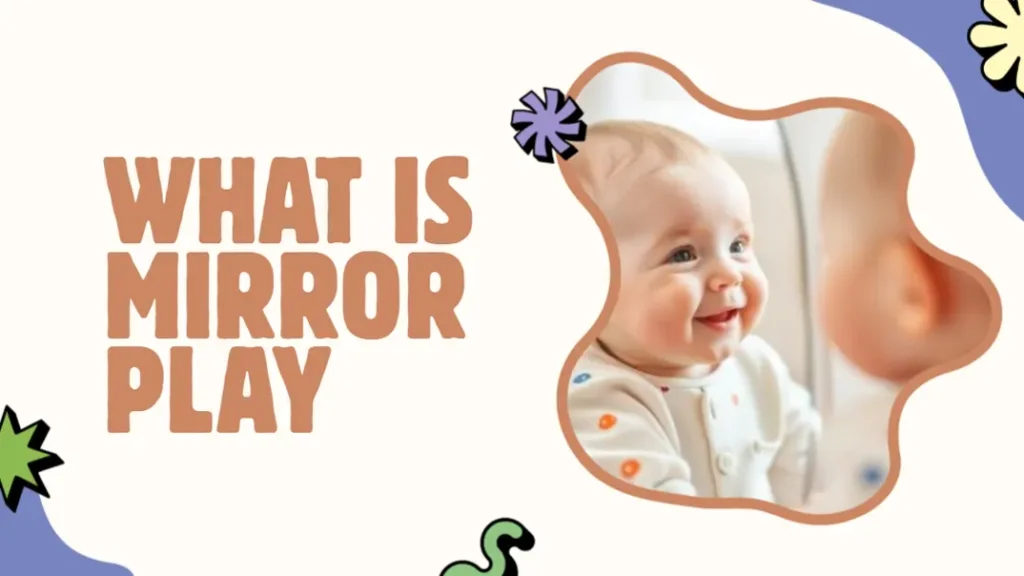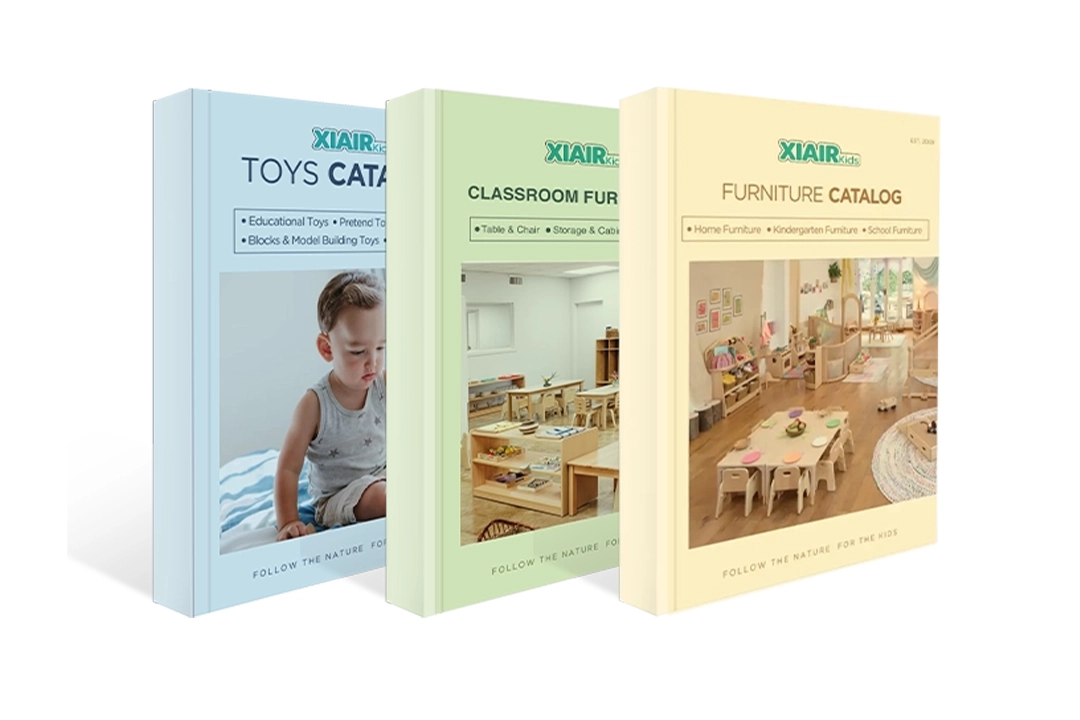Mirror play refers to any activity in which children interact with their own reflection using mirrors. It can be as simple as tummy time with a baby-safe mirror or as creative as drawing self-portraits. Whether children are exploring expressions, naming body parts, or watching their movements, mirror play helps them build self-awareness, emotional understanding, and cognitive skills.
From the first smile to the first self-recognition, a mirror holds more developmental value than most toys. Mirror play allows children to see themselves as both observer and participant, blending sensory input with emotional and cognitive growth.
Research shows that mirror play strengthens body awareness, visual tracking, and social understanding. Babies begin to notice movement and symmetry, toddlers experiment with imitation and gestures, and preschoolers start identifying expressions and describing what they see. Each stage adds a new layer of learning through reflection.
What Are the Benefits of Mirror Play?
Mirror play may seem like a simple activity, but its impact on early development is powerful and far-reaching. From boosting emotional understanding to strengthening physical coordination, mirror play creates a dynamic environment where growth happens naturally through curiosity and interaction.
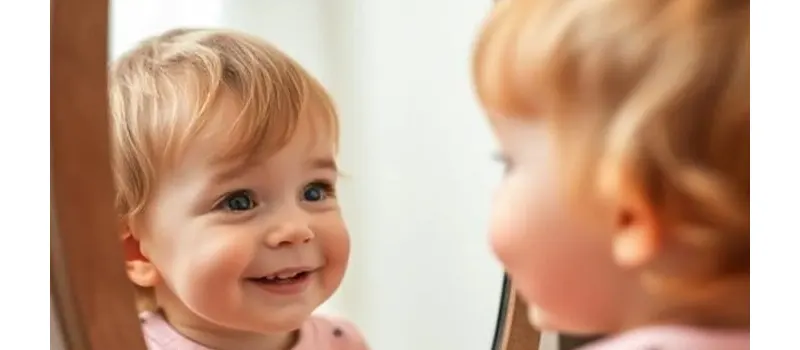
1. Builds Self-awareness and Confidence
When infants see their reflection, they begin to realize that the image in the mirror moves when they move. Over time, this helps them recognize themselves as individuals. This growing sense of identity builds confidence and supports emotional development as they learn who they are and how they appear to others.
| pentas | Julat Umur | Observation and Behavior |
|---|---|---|
| Young infant | Birth to 8 months | Looks curiously at their own reflection. The baby begins to track movement and notice facial expressions without recognizing that the image is their own. |
| Older infant | 6 to 18 months | Smiles, laughs, or makes sounds while looking in the mirror. The child starts to associate the reflection with familiar feelings, showing early signs of recognition. |
| Anak kecil | 15 to 36 months | Begins to touch the nose, head, or another visible body part seen only through the mirror, demonstrating true self-recognition and awareness of identity. |
2. Understanding Object Permanence
Mirror play helps infants understand that people and objects continue to exist even when they are out of sight. When babies see their reflection disappear and reappear as they move, they begin to grasp this concept. Over time, they recognize that the face in the mirror remains theirs, even when they turn away. This early awareness builds memory and a deeper sense of continuity in their environment.
3. Improves Spatial Awareness
Mirror play helps children connect visual input with body movement, teaching them how their position changes in space. As infants and toddlers reach, crawl, or turn toward their reflections, they begin to understand distance, direction, and perspective. These early experiences help them map out the relationship between themselves and the environment, building a foundation for spatial reasoning, navigation, and visual organization.
4. Strengthens Visual and Motor Coordination
Watching and imitating their reflection trains children to synchronize what they see with how they move. Babies follow their eyes and hands as they move together, while toddlers practice clapping, waving, or dancing to match the image in front of them. This repeated observation and imitation sharpen fine and gross motor control, balance, and focus, supporting smoother physical movements and greater body awareness over time.
5. Encourages Emotional and Social Understanding
Through mirror play, children learn to interpret facial expressions and emotions. By mimicking smiles, frowns, or surprise faces, they begin to understand feelings and empathy. In a classroom or group setting, mirror play also promotes social connection as children observe and interact with one another’s reflections.
6. Supports Language and Communication Development
Mirrors invite children to talk about what they see. Parents and teachers can label body parts, describe actions, and ask open-ended questions. This natural back-and-forth builds vocabulary and strengthens expressive language skills in a playful, engaging way.
7. Sparks Creativity and Curiosity
As children grow, mirror play becomes a foundation for imaginative learning. Preschoolers use mirrors to explore symmetry in art, light, and science, or to create characters during pretend play. This creative exploration supports problem-solving, observation, and critical thinking.
Jangan hanya bermimpi, reka bentuk! Jom sembang tentang keperluan perabot tersuai anda!
17 Engaging Mirror Play Ideas for Infants, Toddlers, and Preschoolers
What happens when a child meets their own reflection? For infants, it sparks wonder. For toddlers, it invites movement. For preschoolers, it becomes a stage for stories and self-expression. Mirror play transforms a simple surface into a space for learning, imagination, and discovery. In this section, you’ll find 17 age-appropriate ideas that make mirror play both magical and meaningful at every stage of early development.
Mirror Play Ideas for Infants (0 to 12 months)
Infancy is a time of rapid growth where every sound, movement, and visual cue can shape a baby’s understanding of themselves and the world around them. In Montessori environments, mirrors are often introduced early and positioned to encourage independent exploration, especially during movement or quiet observation time. Mirror play is especially effective during this period because it engages multiple senses at once.

1. Mirror Tummy Time
Tummy time is essential for building the muscles needed for rolling, crawling, and eventually sitting. By introducing a baby-safe mirror during tummy time sessions, you can add an extra layer of engagement. Place the mirror in your baby’s line of sight while they are on their stomach. The shifting reflection can capture their attention, encouraging longer periods of head lifting and shoulder strengthening.
Babies may begin to smile or babble at their reflection, even if they do not yet understand that they are looking at themselves. This early interaction supports visual tracking and nurtures emerging social interest. You can increase the value of the activity by gently narrating what your baby sees, saying things like, “There’s your face,” or “You’re looking so strong today.”
2. Emotion Imitation
Sit beside your infant in front of a mirror where both of your faces are visible. Begin by making gentle, expressive faces like smiling, raising your eyebrows, or opening your mouth wide. As you do this, speak softly and describe what is happening, for example, “Mommy is smiling,” or “Look at those big eyes!”
Although infants will not immediately mimic complex expressions, they are learning to interpret emotional cues. They might smile in return or widen their eyes with curiosity. This type of mirror-based interaction lays an important foundation for emotional development and early bonding.
3. Body Part Naming Game
In front of a mirror, gently touch different parts of your baby’s body and name them out loud. Say, “These are your cheeks,” or “Let’s find your nose.” Point to the corresponding part in the mirror to build the connection between the name, their body, and the reflection.
This activity strengthens both body awareness and language development. Even before babies can speak, they are absorbing words and sounds. Naming body parts in a calm and playful way reinforces these associations in a meaningful, visual context.
4. Peekaboo with a Mirror
Peekaboo is a classic game that teaches babies about object permanence—the idea that people and things continue to exist even when out of sight. When played with a mirror, it becomes even more captivating. Cover the mirror with a cloth and then reveal it while saying, “Peekaboo!” Watch your baby’s expression light up as they see themselves again.
You can also play by briefly covering your baby’s face and then uncovering it to reveal both of your reflections. The repeated appearance and disappearance help build memory and anticipation skills while keeping your baby engaged.

5. Caregiver Face Time
One of the simplest yet most powerful ways to use a mirror with your infant is to sit together and observe both of your reflections. Babies are naturally drawn to faces, especially those of familiar caregivers. As you sit side by side, talk, smile, and make gentle movements. Say phrases like “That’s you,” and “That’s me,” to begin laying the groundwork for self versus other awareness.
This shared mirror time enhances bonding, promotes language development, and provides a soothing visual experience. It also gives your baby a chance to observe expressions in real time, deepening their understanding of communication and emotion.
6. Hand and Foot Discovery
Babies love discovering that their movements make things happen. When placed in front of a mirror, even very young infants may notice their hands waving or feet kicking. You can encourage this by gently moving their limbs and drawing their attention to the mirrored motion. Say, “Look at those busy feet,” or “Your hands are moving so fast!”
This builds early body awareness and coordination, helping your baby link internal sensations with what they see. It also supports visual-motor integration, an important foundation for crawling, grasping, and fine motor skills.
Bilik darjah anda yang sempurna hanya dengan satu klik sahaja!
Mirror Play Ideas for Toddlers (1 to 3 years)
As toddlers begin to recognize themselves in the mirror, their play becomes more intentional, interactive, and expressive. This stage is marked by increasing independence, language development, and physical exploration. Mirror play becomes not just a tool for discovery, but also a gateway to emotional expression, movement, and creativity.
7. Mirror Movement Dance
Toddlers love to move, and a mirror makes that movement even more exciting. Turn on some lively music and invite your child to dance while watching themselves. Encourage them to wave, jump, spin, or clap. Watching their reflection helps them understand how their body moves and reacts.
You can make it more interactive by calling out actions like “Reach up high” or “Touch your toes.” This playful movement builds balance, coordination, and confidence. It also supports body awareness and emotional expression through dance and rhythm.
8. Mirror Blocks
Introduce mirrored blocks or place a small, toddler-safe mirror beside traditional stacking toys. As toddlers explore, they will notice how shapes and colors appear differently when reflected. They may be fascinated by how the blocks seem to multiply or how their hands look as they move near the mirror.
This hands-on exploration supports spatial awareness and visual observation. It encourages early problem-solving and invites your toddler to look at familiar objects from a new perspective.

9. Learn About Symmetry
Stand with your toddler in front of a mirror and play a game of copycat using body movements. Raise one arm, then the other, and invite your child to do the same. You can try making shapes with your arms or clapping slowly while they follow along.
This activity helps toddlers explore the idea that both sides of their body can move in similar ways. It strengthens coordination and introduces early ideas about symmetry and balance in a fun and engaging way.
10. Mirror Cleaning Game
Toddlers often love mimicking adults, especially when it comes to household chores. Hand your toddler a soft cloth or sponge and invite them to “clean” a mirror. They may enjoy wiping in circles or trying to follow a spot they see in the reflection. Add simple encouragement such as “Let’s make it shiny” or “You’re doing a great job.”
This pretend task supports fine motor development and gives toddlers a sense of accomplishment. It also taps into their love of imitating grown-ups and introduces early responsibility in a playful setting.
11. Funny Face Game
Toddlers are naturally expressive, and a mirror lets them see those expressions in real time. This can be both entertaining and educational, helping them connect what they feel with how they look. Playing with facial expressions also strengthens muscles needed for speech and supports the development of empathy and emotional vocabulary.
Encourage your toddler to make funny faces while looking at themselves. Start by showing your own silly expression and ask them to copy it. You can both make wide eyes, puffy cheeks, or big smiles. Describe what you see to add language practice, such as “That’s a silly face” or “You look surprised.” This activity supports emotional awareness and helps toddlers connect feelings with expressions.
Jangan hanya bermimpi, reka bentuk! Jom sembang tentang keperluan perabot tersuai anda!
Mirror Play Ideas for Preschoolers (3 to 5 years)
Preschoolers are full of creativity, imagination, and emotional energy. At this stage, children are learning to express ideas, communicate their feelings, and explore who they are in relation to others. Mirror play becomes a powerful tool for encouraging confidence, storytelling, self-regulation, and fine motor development.

12. Drawing Self-Portraits
Set up a small table with drawing materials such as crayons, colored pencils, and paper. Place a child-safe mirror in front of your preschooler and invite them to draw what they see. You can guide them by saying, “Look at your eyes. What shape are they?” or “Can you draw your smile?”
This activity helps children slow down and observe details about themselves. It strengthens hand-eye coordination, fine motor control, and visual perception. More importantly, it encourages self-awareness and a sense of identity. Over time, preschoolers may begin to add more detail to their drawings, reflecting growing confidence and expressive ability.
13. Mirror Yoga
Introduce simple yoga poses or stretches and encourage your preschooler to try them while watching their reflection. Begin with basic movements such as reaching overhead, standing on one leg, or bending side to side. Use the mirror to help them notice how their body moves and what different poses look like.
This quiet, focused activity supports physical coordination, balance, and mindfulness. It also helps preschoolers develop patience and concentration, as they watch their form and learn to hold poses for a few seconds. Over time, children may begin to lead their own movements and invent their own calming routines.
14. Mirror Dress-Up Station
Provide a variety of costumes, hats, accessories, and fabric pieces that allow preschoolers to explore different roles and characters. Place a full-length mirror near the dress-up area so children can see how they look and act in costume.
As they try on different items and engage in pretend play, preschoolers are building language, storytelling skills, and emotional understanding. The mirror enhances the realism of the play, allowing children to connect their imagination with what they see. This can be especially helpful for children learning to manage emotions or process real-life experiences through role-playing.
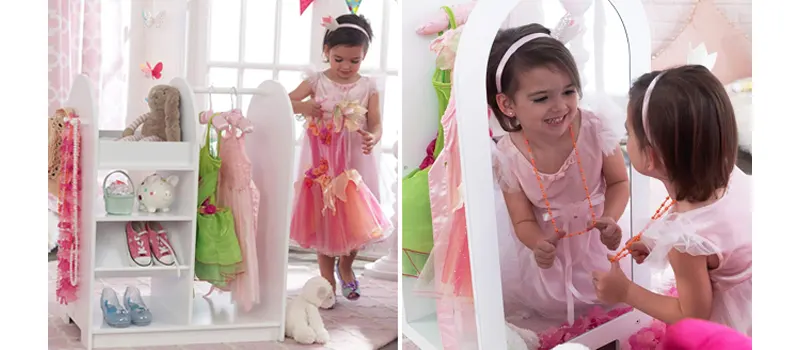
15. Mirror Storytelling
Invite your child to look into a mirror and tell a story to their reflection. You might suggest starting with something familiar, such as “Tell the mirror what you did today,” or “Make up a story about someone who lives inside the mirror.”
This kind of imaginative play fosters language development, narrative thinking, and confidence in speaking. It also provides a safe space for self-expression. Some children may find it easier to talk to a “friend” in the mirror than to adults, which can be especially helpful in building communication skills or easing social anxiety.
16. Emotion Practice
Stand together in front of a mirror and ask your preschooler to show different emotions with their face. You can say, “Can you show me a happy face?” or “What does a sad face look like?” Take turns expressing emotions and talking about what might cause them, such as “I feel excited when we go to the park.”
This activity teaches children to recognize, label, and talk about emotions in themselves and others. It also helps them practice empathy and emotional regulation by making connections between feelings and facial expressions.
17. Acting Out Rhymes or Songs
Choose a familiar nursery rhyme or song that includes movement, such as “Head, Shoulders, Knees, and Toes” or “If You’re Happy and You Know It.” Encourage your preschooler to perform the actions in front of a mirror while singing along.
Seeing their movements in real time makes the experience more engaging and helps improve timing, coordination, and rhythm. This activity blends music, movement, and reflection into a fun and educational experience that supports both cognitive and physical development.
How to Help Children Play with Mirrors Safely and Happily?
Mirror play offers endless learning opportunities, but safety and thoughtful guidance are essential to make the experience positive. With the right setup and supervision, mirrors can become trusted learning tools that support exploration, confidence, and joy.
1. Choose Child-Safe Mirrors
Always use mirrors made from safe, shatter-resistant materials such as acrylic or polycarbonate. These mirrors are designed to withstand handling and are far less likely to cause injury if dropped or bumped. Avoid placing glass mirrors within reach of young children, especially during active play, as traditional glass can break and pose a hazard.

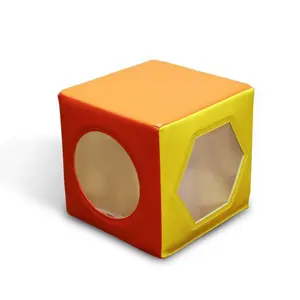
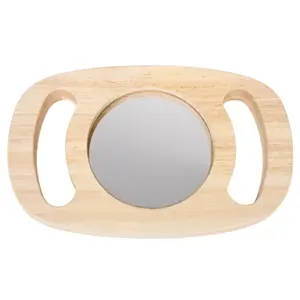
- Floor mirrors
Perfect for babies during tummy time or seated play. These mirrors sit flat or lean safely against a wall so infants can see their reflection easily. - Wall-mounted mirrors
Great for toddlers and preschoolers. They stay fixed at the right height for standing play and are ideal for dancing, copying movements, or dress-up. - Cermin pegang tangan
Small, lightweight mirrors toddlers can hold and explore on their own. Useful for learning about facial features or making expressions. - Mirror play panels
Often seen in classrooms or playrooms. These panels may include different textures or features and are good for group or sensory play. - Mirror cubes or boxes
Fun for building and exploring. Children can place objects inside and see multiple reflections, which builds spatial thinking. - Dress-up mirrors
Tall mirrors with safe edges, used during pretend play or costume changes. Preschoolers love watching themselves act out roles. - Mirror books or toys
Soft or plastic books with built-in mirrors, designed for babies. They are safe for chewing and perfect for quiet or tummy time.
Bilik darjah anda yang sempurna hanya dengan satu klik sahaja!
2. Position Mirrors at the Right Height
To encourage natural exploration, mirrors should be placed at the child’s eye level. For infants, this might mean placing a mirror flat on the floor during tummy time. For toddlers and preschoolers, secure mirrors on the wall or in sturdy frames where children can see their full reflection while sitting or standing. Proper placement helps children engage more meaningfully and safely.
3. Secure Mirrors Properly
Make sure mirrors are fixed securely to prevent tipping or sliding. Floor mirrors should be placed against a stable surface and backed with non-slip material. Wall-mounted mirrors should be anchored safely with child-proof hardware. This ensures that the mirror remains steady during movement-based play and reduces the risk of falls or accidents.
4. Adjust Mirror Play for Different Ages
Mirror play is not one-size-fits-all. As children grow, their interests and abilities change, and the way they interact with mirrors evolves too. Adjusting mirror activities based on age helps keep the experience engaging and developmentally meaningful.
- For infants, focus on simple, passive interaction. Place a baby-safe mirror near them during tummy time or seated play. Let them observe their reflection, hear your voice, and watch your expressions in the mirror. Keep the experience gentle and sensory-based.
- For toddlers, mirror play becomes more interactive. They begin to recognize themselves and enjoy copying movements or making faces. Try games like dancing in front of the mirror, cleaning it with a cloth, or playing simple imitation games that involve pointing to facial features or body parts.
- For preschoolers, mirror play can support creativity, emotional learning, and self-expression. Encourage dress-up activities, storytelling in front of the mirror, or drawing self-portraits. You can also use mirrors to talk about emotions and explore facial expressions together.
5. Supervise Play and Provide Gentle Guidance
While mirror play is often self-directed, supervision is still essential—especially for younger children. Sit nearby, observe, and join in when appropriate. Gently model safe behavior and mirror-based games, like making faces or naming body parts. Active supervision helps prevent accidents and gives children the comfort of knowing you’re close and engaged.
6. Support Emotional Comfort and Confidence
Some children may feel unsure or even uncomfortable when first seeing their reflection. Offer emotional support by smiling with them, using warm, reassuring words, and joining in the play. Say things like “That’s you!” or “I see your happy face!” This positive feedback builds emotional security and helps children enjoy mirror play without fear or confusion.
7. Maintain a Clean and Inviting Space
A clean mirror and a soft play area make a big difference in how children experience mirror play. Regularly wipe mirrors to remove fingerprints and smudges so children can see their reflection clearly. Add soft rugs, pillows, or foam mats around the mirror to create a safe and cozy play environment, especially for crawling infants or children playing on the floor.
Soalan Lazim
At what age can I introduce mirror play to my child?
You can introduce mirror play as early as the first few months of life. Even newborns enjoy looking at faces and high-contrast images. Around 3 to 4 months, babies start responding to their reflection, and by 18 months, many toddlers begin to recognize themselves in the mirror.
How long should mirror play sessions be?
Playing with mirrors does not need to be long to be effective. For infants, even a few minutes during tummy time is beneficial. Toddlers and preschoolers can enjoy mirror play for 10 to 20 minutes, especially when it’s part of a larger activity like dancing, storytelling, or dress-up.
Is it safe for children to play with mirrors at home or in classrooms?
Yes, it is safe when using mirrors made of acrylic or polycarbonate instead of glass. Always secure mirrors firmly at child height, check edges for safety, and supervise closely. Safe environments help children play with mirrors confidently and without risk of injury.
What should I do if a child is afraid to play with mirrors?
Stay calm and supportive. Sit with the child and show them your reflection first. Use gentle words like “That’s you” or “Look, we’re together.” Don’t force them to engage. Instead, let them watch from a distance or use a toy to make the mirror feel more friendly. With time and encouragement, most children become more comfortable.
How do I know if my child recognizes themselves in the mirror?
One way to tell is through the “blush test.” Gently place a small dot of lipstick or blush on your child’s nose without them noticing, then let them look into a mirror. If they touch their own nose instead of the mirror, it usually means they recognize the reflection as themselves. This kind of self-recognition often begins around 18 months of age, but every child develops at their own pace.
Kesimpulan
Mirror play is a gentle window into how children see and understand themselves. When children play with mirrors, they begin a lifelong journey of self-discovery, coordination, and emotional growth. Each smile, movement, or curious gaze in the mirror helps them connect body, mind, and feeling in meaningful ways.
Pada Xiair, we believe that a prepared environment is key to meaningful learning. Our range of Montessori mirrors and early childhood furniture is thoughtfully designed to encourage independent exploration and safe self-discovery. From low wall mirrors for toddlers to full-length reflective panels for classrooms, every piece is crafted to support natural development and joyful learning.

